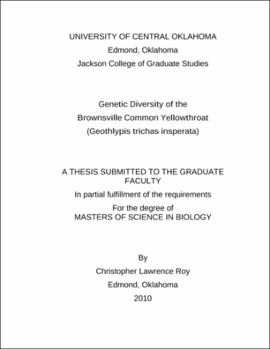| dc.contributor.advisor | Butler, Christopher | |
| dc.contributor.author | Roy, Christopher Lawrence | |
| dc.date.accessioned | 2020-05-26T20:34:31Z | |
| dc.date.available | 2020-05-26T20:34:31Z | |
| dc.date.issued | 2010 | |
| dc.identifier.other | (AlmaMMSId)9974615085202196 | |
| dc.identifier.uri | https://hdl.handle.net/11244/324626 | |
| dc.description.abstract | Habitat fragmentation is particularly severe in the Lower Rio Grande Valley (LRGV) of south Texas, where an estimated 95% of the native brushland has been eliminated by agriculture and urban development. This fragmentation effectively divides bird populations into smaller "subpopulations within a population," or a metapopulation. Fragmentation has divided wetland habitat where wetlands are more dense close to the Rio Grande River and becomes more scattered north of the River. Therefore, bird species who utilize the wetlands close to the River should be denser and more closely related, genetically, than individuals farther north. A good model for studying the effects of fragmentation in the LRGV is the "Brownsville" Common Yellowthroat ix (Geothlypis trichas insperata), a subspecies of the Common Yellowthroat. Klicka (1994) studied the Brownsville Common Yellowthroat and concluded that they were restricted to the southern third of Cameron County and they were most common along the Rio Grande River. Several predictions were tested. (1) Apparent survivorship of Brownsville Yellowthroats in the LRGV has not changed since the 1988-1989 study conducted by Klicka (1994). (2) Linear density of Brownsville Yellowthroats is greatest nearer to the River. (3) I expect individuals on or near the Rio Grande River to be more closely related than northern individuals. (4) The source-sink metapopulation model should be the model best fit to describe this subspecies. Blood samples were collected from captured individuals (n = 128) for microsatellite testing. Samples were examined with a genetic analyzer and subjected to tests using programs STRUCTURE, CERVUS, GENEPOP, and RELATEDNESS. Apparent survivorship for this study (34%) was lower than that reported by Klicka (55%; 1994). The linear densities of sites near the Rio Grande River and far from the River were not significantly different. Analysis of genetic relatedness indicates that individuals are as related to each other as would be expected in distant relatives. Therefore, these data indicate that a single, admixed population is present in the LRGV which most closely resembles an open population model. | |
| dc.rights | All rights reserved by the author, who has granted UCO Chambers Library the non-exclusive right to share this material in its online repositories. Contact UCO Chambers Library's Digital Initiatives Working Group at diwg@uco.edu for the permission policy on the use, reproduction or distribution of this material. | |
| dc.subject.lcsh | Yellowthroat | |
| dc.subject.lcsh | Animal population genetics | |
| dc.subject.lcsh | Ecological heterogeneity | |
| dc.title | Genetic diversity of the Brownsville common yellowthroat (Geothlypis trichas insperata). | |
| dc.type | Academic theses | |
| dc.contributor.committeeMember | Haynie, Michelle L., 1975- | |
| dc.contributor.committeeMember | Hellack, Jenna | |
| dc.thesis.degree | M.S., Biology | |
| dc.identifier.oclc | (OCoLC)ocn671253434 | |
| thesis.degree.grantor | Jackson College of Graduate Studies | |
